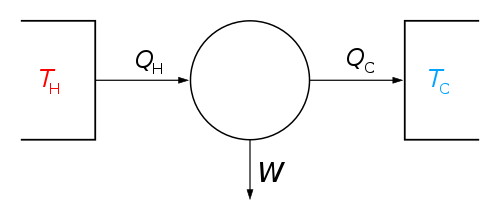Quasistatic process
In thermodynamics, a quasi-static process is a thermodynamic process that happens slowly enough for the system to remain in internal equilibrium. An example of this is quasi-static compression, where the volume of a system changes at a slow rate enough to allow the pressure to remain uniform and constant throughout the system.[1]
| Thermodynamics | ||||||||||||
|---|---|---|---|---|---|---|---|---|---|---|---|---|
 The classical Carnot heat engine | ||||||||||||
|
||||||||||||
| ||||||||||||
Quasi means ‘as if’.[2] This process is a succession of equilibrium states and infinite slowness is its characteristic feature.[3]
Only in quasistatic process can we define intensive quantities (like Pressure, Temperature, Specific volume, Specific entropy) of the system at every instant during the whole process; Otherwise, since no internal equilibrium is established, different parts of the system would have different values of these quantities.
Any reversible process is a quasi-static one. However, quasi-static processes involving entropy production are not reversible. An example of a quasi-static process that is not reversible is a compression against a system with a piston subject to friction— although the system is always in thermal equilibrium, the friction ensures the generation of dissipative entropy, which directly goes against the definition of reversible; alternatively, one can say that friction would generate heat and dissipative entropy only if the movement of the piston were not infinitely slow. A notable example of a process that is not even quasi-static is the slow heat exchange between two bodies on two finitely different temperatures, where the heat exchange rate is controlled by an approximately adiabatic partition between the two bodies— in this case, no matter how slowly the process takes place, the states of the composite system consisting of the two bodies is far from equilibrium, since thermal equilibrium for this composite system requires that the two bodies be at the same temperature.
Some ambiguity exists in the literature concerning the distinction between quasi-static and reversible processes, as these are sometimes taken as synonyms. The reason is the theorem that any reversible process is also a quasi-static one, even though (as we have illustrated above) the converse is not true. In practical situations, it is essential to differentiate between the two: any engineer would remember to include friction when calculating the dissipative entropy generation, so there are no reversible processes in practice. The definition given above is closer to the intuitive understanding of the word “quasi-” (as if) “static” and remains technically different from reversible processes.
PV-Work in various quasi-static processes
- Constant pressure: Isobaric processes,
- Constant volume: Isochoric processes,
- Constant temperature: Isothermal processes,
- where P varies with V via , so
- Polytropic processes,
References
- Schroeder, Daniel (2000). An Introduction to Thermal Physics. United States: Addison Wesley Longman. pp. 20–21. ISBN 0-201-38027-7.
- Lewis, C.T., Short, C. (1879). A Latin Dictionary, Clarendon Press, Oxford, page 1507.
- Rajput, R.K. (2010). A Textbook of Engineering Thermodynamics, 4th edition, Laxmi Publications (P) Ltd, New Delhi, pages 21, 45, 58.